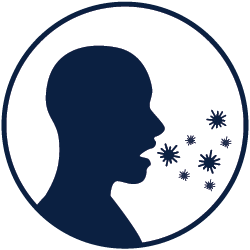Contact Info
Office of Public Safety
- emergencymanagement@georgiasouthern.edu
- 912-478-3015
-
PO Box 8072
Statesboro, GA 30458

Both influenza (flu) and COVID-19 are contagious respiratory illnesses, but they are caused by different viruses. Flu is caused by influenza viruses, while COVID-19 is caused by the SARS-CoV-2 coronavirus. Because they share many similar symptoms, it can sometimes be difficult to tell them apart without testing.
Signs & Symptoms
Flu Symptoms
- Fever or feeling feverish/chills*
- Cough
- Sore throat
- Runny or stuffy nose
- Muscle or body aches
- Headache
- Fatigue (very tired)
- Vomiting or diarrhea (more common in children)
COVID-19 Symptoms
- Fever or chills*
- Cough
- Shortness of breath or difficulty breathing
- Loss of taste or smell
- Muscle or body aches
- Headache
- Fatigue
- Congestion, sore throat, or runny nose
*Not everyone with flu or COVID-19 will have a fever.
How They Spread
- Flu: Spreads mainly through droplets when people with flu cough, sneeze, or talk. It can also spread by touching surfaces contaminated with the virus.
- COVID-19: Spreads primarily through respiratory droplets and smaller particles (aerosols) when an infected person breathes, talks, coughs, or sneezes. COVID-19 is also known to spread more easily in crowded or poorly ventilated spaces compared to flu.
Contagious Period
- Flu: Most healthy adults can infect others from 1 day before symptoms develop and up to 5–7 days after becoming sick.
- COVID-19: People can spread the virus 1–2 days before symptoms appear and remain contagious for at least 5–10 days, sometimes longer depending on illness severity.
Prevention Tips
To help prevent both flu and COVID-19:
- Maintain healthy habits – adequate sleep, hydration, stress management, and good nutrition.
- Get vaccinated – annual flu shots and recommended COVID-19 vaccines/boosters.
- Stay home when sick to avoid spreading illness to others.
- Cover coughs and sneezes with a tissue or the inside of your arm.
- Wash your hands often with soap and water, or use hand sanitizer if soap is unavailable.
- Avoid touching your eyes, nose, and mouth.
- Wear a mask in crowded or high-risk indoor settings, especially during outbreaks.
- Improve ventilation in indoor spaces when possible.
